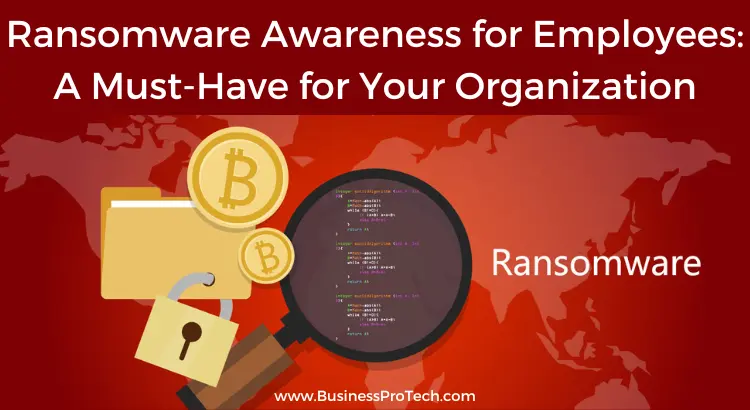In an increasingly digital world, where data is the lifeblood of organizations, the threat of ransomware has emerged as a major concern. Ransomware attacks have the potential to harm businesses, compromise sensitive information, and disrupt operations. Amidst this backdrop, cultivating ransomware awareness among employees has become imperative for organizational security.
This article delves into the critical role of ransomware awareness, examining the risks, impacts, and measures that organizations should undertake to safeguard their digital assets.

The Rising Threat Landscape
In recent years, ransomware attacks have risen to alarming levels, targeting businesses of all sizes and industries. Cybercriminals exploit vulnerabilities in an organization’s digital infrastructure, encrypting crucial data and demanding hefty ransoms for its release.
These attacks have far-reaching consequences, from financial losses to reputational damage. By understanding the evolving threat landscape, employees can become the first line of defense against ransomware.
As the tactics employed by cybercriminals continue to evolve, so too must the awareness and preparedness of employees. Ransomware attacks have grown increasingly sophisticated, often utilizing advanced techniques to bypass traditional security measures. By staying informed about the latest attack vectors and remaining vigilant, employees can actively contribute to the early detection and mitigation of ransomware threats. This proactive stance not only enhances the organization’s security posture but also empowers employees to play an instrumental role in safeguarding the digital ecosystem.
Human Element: A Gateway for Ransomware
The human element remains a significant gateway for ransomware attacks. Cybercriminals often rely on tactics like phishing emails to trick employees into unwittingly downloading malicious software.
Via skillfully executed social engineering tactics; attackers manipulate individuals into revealing confidential information or interacting with malicious links. Educating employees about these tactics and fostering a culture of skepticism can significantly reduce the risk of falling victim to such attacks.
Moreover, promoting a culture of cybersecurity awareness goes beyond formal training sessions. It involves encouraging open discussions about potential threats, sharing real-world examples of successful attacks, and showcasing the tangible impact of maintaining vigilance. When employees grasp the gravity of their role in protecting organizational assets, they become more invested in adopting security best practices.

Regularly engaging staff in discussions about cybersecurity transforms them into proactive defenders who actively contribute to fortifying the organization’s digital resilience. This synergy between education and engagement serves as a potent deterrent against ransomware attacks, making it markedly more challenging for cybercriminals to exploit human vulnerabilities.
Role of Ransomware Awareness Training
Training employees in ransomware awareness assumes a crucial role in providing them with the necessary knowledge and abilities to detect and address potential threats effectively. Consistent training sessions should encompass subjects like spotting phishing endeavors, adopting secure browsing methods, and cultivating safe downloading behaviors. By keeping employees well-informed about the latest attack techniques, organizations empower them to make informed decisions that protect the integrity of digital assets.
Furthermore, the benefits of ransomware awareness training extend beyond mere technical knowledge. These sessions foster a sense of responsibility and ownership among employees, reinforcing the idea that cybersecurity is a collective effort. When individuals understand how their actions directly impact the organization’s security posture, they are more likely to adhere to best practices and remain vigilant. This synergy between knowledge and personal investment creates a formidable defense mechanism against ransomware attacks.
Additionally, providing employees with a platform to ask questions, share concerns, and report suspicious activities further enhances the effectiveness of ransomware awareness initiatives.
Collaboration Between IT and Employees
A collaborative approach between the IT department and employees is essential in fortifying an organization’s defenses against ransomware. IT teams can provide insights into emerging threats, implement robust cybersecurity measures, and establish incident response protocols. Employees, on the other hand, contribute by promptly reporting suspicious activities, adhering to security policies, and participating actively in training programs. This synergy ensures a comprehensive defense strategy that is far more resilient to ransomware attacks.

When IT professionals and employees collaborate, a dynamic feedback loop emerges. IT teams gain valuable insights from frontline employees, helping them understand evolving attack vectors and vulnerabilities. This information enables IT to fine-tune their security infrastructure, anticipate potential threats, and stay one step ahead of cybercriminals.
On the other side, employees benefit from the technical expertise of IT, gaining a deeper understanding of the complexities involved in safeguarding digital assets. This shared knowledge fosters a sense of unity and collective responsibility, reinforcing the organization’s ability to withstand ransomware assaults.
Beyond Technical Solutions: A Cultural Shift
While technological safeguards are crucial, instilling a cybersecurity-conscious culture within the organization is equally vital. This cultural shift involves promoting accountability, transparency, and open communication. Employees should feel empowered to report security concerns without fear of repercussions. Regular cybersecurity assessments, rewards for proactive security behavior, and leadership support all contribute to creating an environment where ransomware awareness becomes second nature.
Safeguarding the Digital Future
In the face of escalating ransomware threats, organizations must recognize that the battle against cybercriminals requires a united front. Ransomware awareness among employees serves as a formidable defense mechanism, bolstered by continuous training, collaboration, and a culture that values cybersecurity. By embracing these principles, organizations can fortify their digital infrastructure and confidently navigate the intricate landscape of the modern digital era. The path to a secure digital future begins with an informed and vigilant workforce.